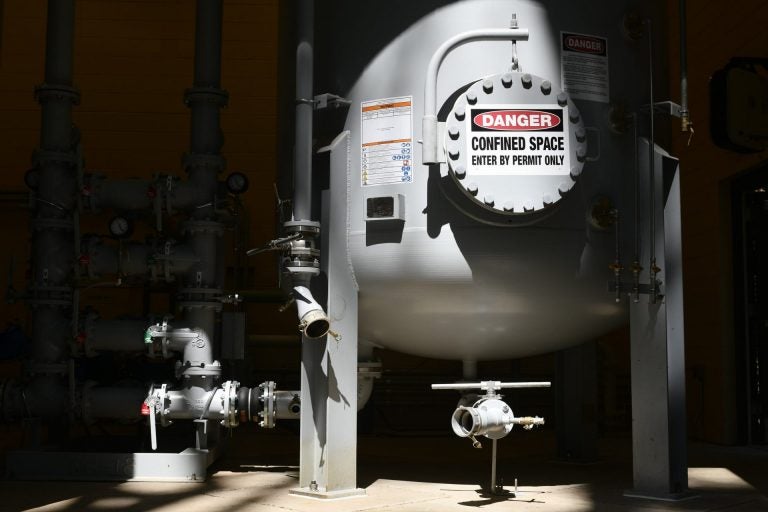DEP finds PFAS in one-third of Pa. public water systems; none exceeded EPA limit
Officials plan to finish testing by the end of March and say they will propose regulations this year that would set health limits for some of the chemicals.

Detailed view on the newly installed system to filter out PFAS Forever Chemicals at Well #2 of the Horsham Water and Sewer Authority facility in Horsham, Pa., on August 22, 2019. (Bastiaan Slabbers for WHYY)
This story originally appeared on StateImpact Pennsylvania.
___
About one-third of 114 Pennsylvania water systems tested for toxic PFAS chemicals were found to contain the substances over 17 months of sampling, although none exceeded a federal health advisory level for two of the most common chemicals, the Department of Environmental Protection said.
Amid growing national alarm about the presence of the so-called forever chemicals in drinking water, Pennsylvania has been testing water sources since June 2019 at the direction of Gov. Tom Wolf’s PFAS Action Team, which was set up by an executive order in 2018.
Officials plan to finish testing by the end of March and say they will propose regulations this year that would set health limits for some of the chemicals, as some states including New Jersey have done already, in the absence of federal requirements.
Testing was suspended from March to July last year because of the Covid-19 pandemic but resumed in August with appropriate health precautions, DEP said in a statement earlier this month.
“In the interests of public health and environmental safety, we are continuing to make strides to ensure that we can determine PFAS contamination levels in Pennsylvania,” DEP Secretary Patrick McDonnell said. “Although Covid-19 has impacted us all, it has not prevented us from making progress.”
Health levels known as Maximum Contaminant Limits would require affected systems to install filters to ensure their customers were not being exposed to hazardous levels of the chemicals that are linked to illnesses including some cancers, immune system impairments, developmental problems in young children, ulcerative colitis, and elevated cholesterol.
In the absence of its own limits for two of the most common PFAS chemicals – PFOA and PFOS – Pennsylvania still uses the U.S. Environmental Protection Agency’s combined guidance level of 70 parts per trillion (ppt) as an upper limit. Many scientists say that is far too high to protect public health from chemicals that can be dangerous even at very low doses.
Campaigners have long criticized the EPA for failing to set enforceable national health limits for the chemicals. But the Biden administration has restarted the agency’s steps toward regulation with plans for a new round of testing and the start of a regulatory process that would eventually produce national standards.
In New Jersey, officials last year finalized limits of 14 ppt and 13 ppt for PFOA and PFOS, respectively, about one-fifth the level set by the EPA. In 2018, the state became the first to set a strict limit for another common PFAS chemical, PFNA.
The man-made chemicals, formally known as Per- and Polyfluoroalkyl Substances, have been used since the 1940s in a range of consumer products including non-stick cookware, flame-retardant fabrics, and some food packaging. They have also been used for years by the military in fire-fighting foam, resulting in high contamination levels on some military bases and in the ground water that provides drinking water for surrounding communities.
Business and the military have reduced their use of PFAS in response to health concerns, but the chemicals persist for years even if their use has ended because they don’t break down in the environment, earning the title “forever chemicals.”
Pennsylvania is not testing private wells, which serve some 3.5 million Pennsylvanians, or about a quarter of population, in the current round. But the state says it will help communities and private well owners whose water exceeds the EPA’s advisory level for PFOA and PFOS. The DEP also said it would change groundwater and soil-remediation standards for three of the chemicals: PFOA, PFOS and PFBS.
The DEP said it has identified 493 public water systems as potential sampling sites because they are within half a mile of a potential source of PFAS contamination. It plans to eventually test about 360 of them, as well as 40 sources that are outside the half-mile limit, and would establish a testing baseline.
Some of the highest PFAS concentrations have been found in Berks, Bucks and Montgomery counties. Christman Lake Water System in Berks County, for example, was found in February 2020 to contain 66 ppt of PFOA and PFOS combined – just below the EPA level but much higher than the levels that New Jersey has set as the health limit for each chemical.
In Bucks County, Doylestown Borough Water Department was found with 25 ppt of the two chemicals combined in August 2020 – well within the EPA limit but still about twice the New Jersey standard. And in Montgomery County, Audubon Water Co. was found in February 2020 with the same 25 ppt level.
In addition to those counties, chemicals were detected at sites in Chester, Columbia, Delaware, Lancaster, Lycoming, Monroe, Northampton and Philadelphia counties.
Pennsylvania tested for 18 kinds of PFAS chemicals and found seven of them including PFOA, PFOS and PFNA, present at 35 percent of the sites.
Some of the state’s highest PFAS levels have been found in the Horsham/Warminster area of Bucks and Montgomery counties where two shuttered military bases have been identified as contamination sources.
Although that area was not among those sampled in the latest round of state testing, earlier samples have shown PFAS contamination of water on and around the bases at thousands of times above the EPA’s health limit. The site is one of seven around the country that are participating in a federal study of the effects of PFAS on human health; recruitment of local people to provide blood samples is expected to start this summer.
Joanne Stanton, co-founder of Buxmont Coalition for Safer Water, which campaigns for PFAS removal, said the state tests covered only a fraction of some 9,000 PFAS chemicals that are known to exist.
“We need to keep pushing the federal government and state of PA to set enforceable drinking water standards for PFAS,” she said. “These are forever chemicals with a single exposure lasting in the human body for 10 to 20 years and a list of health effects that keeps growing and growing.”
Stanton argued that Pennsylvania is well behind some other states in regulating PFAS, and that private well owners are especially at risk because their wells are not being tested.
“With no sampling of private wells or other potential hot spots, the results are nothing to brag about but instead begs us to ask: What is the trigger point for PFAS action in our state?” she said.
Tracy Carluccio of the environmental group Delaware Riverkeeper Network said that even if 65 percent of the DEP’s tests failed to detect PFAS, the sampling still shows a significant impact in the state. No level of the chemicals is safe, she said, and “there are people in Pennsylvania drinking water that is contaminated with PFAS at concentrations that are known to be linked to serious adverse health effects.”
Carluccio, a longtime campaigner for strict PFAS regulation, said Pennsylvania should widen its sampling to include possible sources such as stormwater and wastewater treatment plants and sewage sludge, and she urged officials to monitor for air transmission in light of evidence that the chemicals have spread by air in some places.
“My worry is that by narrowing what they sample, PA will end up with the false conclusion that it is not a big statewide problem, when we really don’t know unless they widely sample,” she said.
WHYY is your source for fact-based, in-depth journalism and information. As a nonprofit organization, we rely on financial support from readers like you. Please give today.






